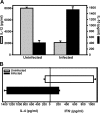A role for IgG immune complexes during infection with the intracellular pathogen Leishmania
- PMID: 15753208
- PMCID: PMC1351290
- DOI: 10.1084/jem.20041470
A role for IgG immune complexes during infection with the intracellular pathogen Leishmania
Abstract
We examined the role of immunoglobulin (Ig)G antibodies in mediating host defense to the intracellular parasite, Leishmania. We show that IgG not only fails to provide protection against this intracellular pathogen, but it actually contributes to disease progression. The J(H) strain of BALB/c mice, which lack IgG because they have a targeted deletion in the Ig heavy chain (J) locus, were more resistant to infection with Leishmania major than were normal BALB/c mice. However, the passive administration of anti-Leishmania IgG caused J(H) mice to develop large lesions containing high numbers of parasites. Antibody administration correlated with an increase in interleukin (IL) 10 production in lesions, and blocking the murine IL-10 receptor prevented antibody-mediated disease exacerbation. In human patients with active visceral leishmaniasis, high IgG levels are predictive of disease. Patients with ongoing disease had high IgG antibody titers and no delayed-type hypersensitivity (DTH) responses to Leishmania antigens. This pattern was reversed upon disease resolution after treatment, resulting in a decrease in total IgG, which was accompanied by a progressive increase in DTH responsiveness. We conclude that IgG can cause a novel form of immune enhancement due to its ability to induce IL-10 production from macrophages.
Figures









Similar articles
-
F₁ cross-breed between susceptible BALB/c and resistant Swiss mice infected with Leishmania major exhibit an intermediate phenotype for lesion sizes and type 1 cytokines but show low level of total IgG antibodies.Scand J Immunol. 2014 May;79(5):283-91. doi: 10.1111/sji.12159. Scand J Immunol. 2014. PMID: 24498914
-
Exacerbation of murine cutaneous leishmaniasis by adoptive transfer of parasite-specific helper T cell populations capable of mediating Leishmania major-specific delayed-type hypersensitivity.J Immunol. 1984 Sep;133(3):1594-600. J Immunol. 1984. PMID: 6205088
-
Lower levels of IgG1 in comparison with IgG2a are associated with protective immunity against Leishmania tropica infection in BALB/c mice.J Microbiol Immunol Infect. 2017 Apr;50(2):160-166. doi: 10.1016/j.jmii.2015.05.007. Epub 2015 May 14. J Microbiol Immunol Infect. 2017. PMID: 26066544
-
Distinct immunological states in murine cutaneous leishmaniasis by immunising with different amounts of antigen: the generation of beneficial, potentially harmful, harmful and potentially extremely harmful states.Behring Inst Mitt. 1997 Feb;(98):153-9. Behring Inst Mitt. 1997. PMID: 9382736 Review.
-
[Leishmaniasis: principles of the immune response and function of nitric oxide].Berl Munch Tierarztl Wochenschr. 1998 Nov-Dec;111(11-12):409-14. Berl Munch Tierarztl Wochenschr. 1998. PMID: 9880934 Review. German.
Cited by
-
Identification of new antigens in visceral leishmaniasis by expression cloning and immunoblotting with sera of kala-azar patients from Bihar, India.Infect Immun. 2005 Oct;73(10):7018-21. doi: 10.1128/IAI.73.10.7018-7021.2005. Infect Immun. 2005. PMID: 16177384 Free PMC article.
-
Deletion of IL-4Ralpha on CD4 T cells renders BALB/c mice resistant to Leishmania major infection.PLoS Pathog. 2007 May 11;3(5):e68. doi: 10.1371/journal.ppat.0030068. PLoS Pathog. 2007. PMID: 17500591 Free PMC article.
-
Engineering of Fc Multimers as a Protein Therapy for Autoimmune Disease.Front Immunol. 2020 Mar 25;11:496. doi: 10.3389/fimmu.2020.00496. eCollection 2020. Front Immunol. 2020. PMID: 32269572 Free PMC article. Review.
-
Analysis of the Antigenic and Prophylactic Properties of the Leishmania Translation Initiation Factors eIF2 and eIF2B in Natural and Experimental Leishmaniasis.Front Cell Infect Microbiol. 2018 Apr 5;8:112. doi: 10.3389/fcimb.2018.00112. eCollection 2018. Front Cell Infect Microbiol. 2018. PMID: 29675401 Free PMC article.
-
An in vitro model of antibody-enhanced killing of the intracellular parasite Leishmania amazonensis.PLoS One. 2014 Sep 5;9(9):e106426. doi: 10.1371/journal.pone.0106426. eCollection 2014. PLoS One. 2014. PMID: 25191842 Free PMC article.
References
-
- Berman, J. 2003. Current treatment approaches to leishmaniasis. Curr. Opin. Infect. Dis. 16:397–401. - PubMed
-
- Melby, P.C. 2002. Recent developments in leishmaniasis. Curr. Opin. Infect. Dis. 15:485–490. - PubMed
-
- Kane, M.M., and D.M. Mosser. 2001. The role of IL-10 in promoting disease progression in leishmaniasis. J. Immunol. 166:1141–1147. - PubMed
-
- Noben-Trauth, N., R. Lira, H. Nagase, W.E. Paul, and D.L. Sacks. 2003. The relative contribution of IL-4 receptor signaling and IL-10 to susceptibility to Leishmania major. J. Immunol. 170:5152–5158. - PubMed
Publication types
MeSH terms
Substances
Grants and funding
LinkOut - more resources
Full Text Sources
Other Literature Sources
Medical
Molecular Biology Databases

